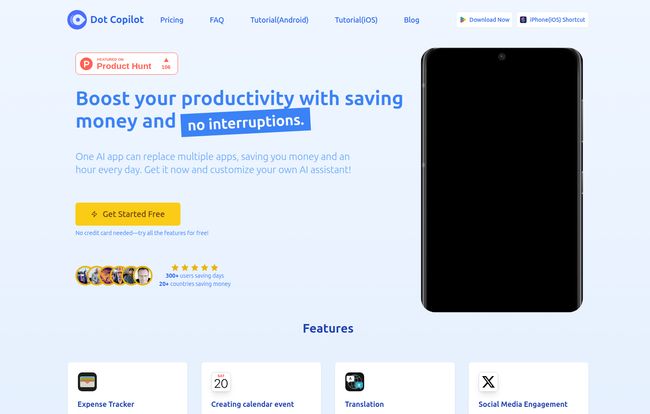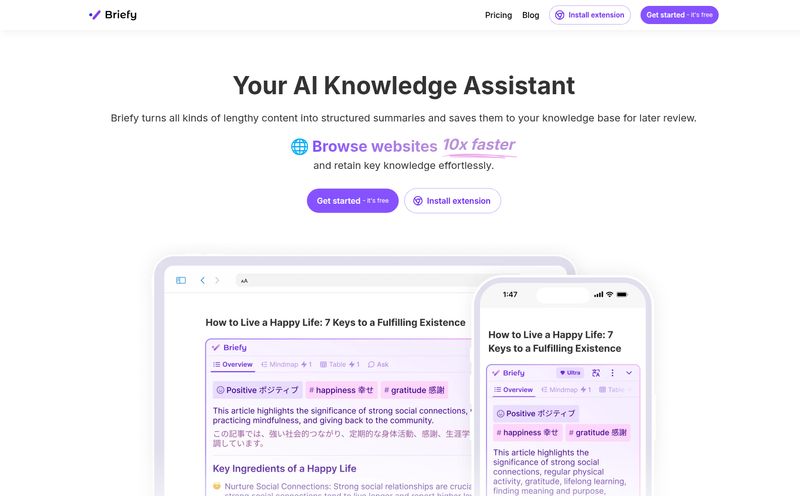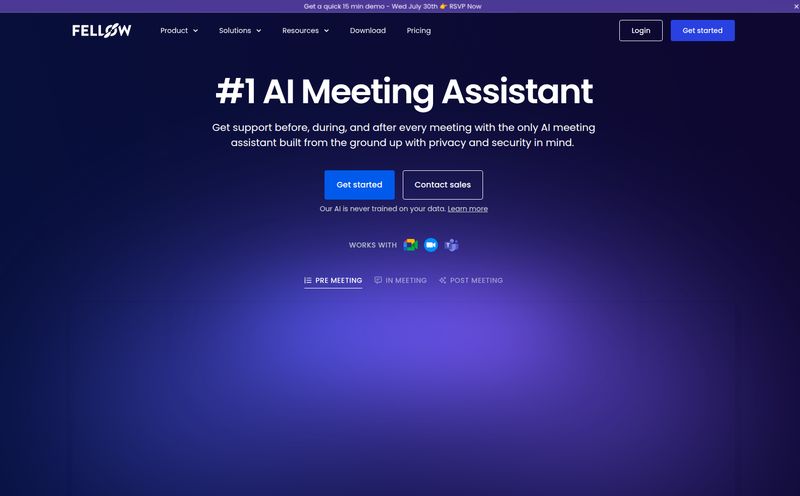Our phones are a mess. We have an app for notes, another for to-do lists, a calendar that barely syncs with the meeting invites buried in our chat threads, and probably three different apps for budgeting. It’s supposed to be smart, but most days it feels like we’re the ones doing all the work, toggling between screens like a digital acrobat. I've been in the SEO and traffic game for years, and my screen time is... let's just say, impressive. And a lot of that is just wasted time on digital admin.
So when I heard about Dot Copilot, I was intrigued but skeptical. Another AI-powered productivity app? The market’s flooded with them. But this one felt a little different. It claims to be an on-screen assistant that can “see” what you’re doing and help out. Think of it like a personal intern living in your phone, but one that doesn’t need coffee breaks. So, I took it for a spin.

Visit Dot Copilot
So, What Exactly Is This Dot Copilot Thing?
In simple terms, Dot Copilot is an AI assistant for both Android and iPhone that uses the smarts of ChatGPT to understand the content—text and sometimes images—right on your screen. You don’t need to copy and paste stuff between apps anymore. It’s designed to read a chat, a webpage, or a receipt and just do the thing you need to do.
For example, a friend texts you, “Hey, let’s grab lunch at The Corner Bistro next Tuesday at 1 pm?” Instead of jumping over to your calendar app to manually input everything, you can have Dot Copilot see that text and create the calendar event for you. It sounds simple, but when you add up all those little actions over a day, the time saved is pretty staggering. It’s all about reducing the friction of daily digital tasks.
My Favorite Features (The Ones I Actually Use)
An app can have a million features, but what matters is what you’ll use day-to-day. After playing around with it, a few things really stood out to me.
Taming the To-Do List and Calendar Chaos
This is the big one for me. My WhatsApp and Telegram are a constant stream of informal requests and plans. “Can you send me that report?” or “Don’t forget to pick up milk.” Dot Copilot can pull those tasks directly from a chat or a screenshot and pop them into your Reminders. No more “Oh, I completely forgot about that!” moments. The calendar integration is just as smooth, turning vague plans into concrete appointments. This feature alone cleans up so much mental clutter.
The Google Sheets Integration is a Godsend
Okay, this is where my inner marketing nerd gets excited. Dot Copilot has an Expense Tracker that syncs directly with Google Sheets. You can literally take a picture of a receipt or let it read an invoice in an email, and it will extract the vendor, date, and amount, and log it in a spreadsheet for you. For freelancers, small business owners, or anyone who dreads doing their expenses, this is incredible. We all live in Google Workspace anyway, so having an AI that feeds data directly into a Sheet without me having to do it manually is a massive win.
Going Beyond Simple Commands
Here’s where the real power user potential comes in. Dot Copilot lets you create Custom Commands and Actions. This is a bit more advanced, but it’s fantastic. You can essentially 'program' it to perform specific, repetitive tasks you do often. For instance, if you’re a social media manager, you could create a command to generate three engaging comment variations for a LinkedIn post based on the post's text. It's about making the AI work for your specific workflow, not just giving you generic help.
Quick Summaries and On-the-Fly Translations
I often have to skim through long articles or reports for trend analysis. The Web Summarization tool is a lifesaver. It gives you the gist of a long webpage without you having to read every single word. The on-screen translation is also brilliant, especially for dealing with international clients or just browsing foreign websites. It feels much more integrated than constantly copying text into Google Translate.
Let’s Talk Money. How Much Does Dot Copilot Cost?
Alright, the all-important question: what’s the damage to the wallet? The pricing structure is actually pretty straightforward, which I appreciate. They have a few tiers, from free to a powerhouse plan.
| Plan | Price | Who It's For | Key Features |
|---|---|---|---|
| Free | $0 | The Curious Tester | 5 requests/day, GPT-4o-mini, basic features. Perfect for a test drive. |
| Starter | $9.00 / year | The Casual User | 1000 requests/year, GPT-4o-mini, all core features. |
| Advanced | $19.90 / year | The Professional | 1000 requests/year, smarter GPT-4o model, priority support. |
| Ultimate | $29.90 / year | The Power User | Same as Advanced, plus superior visual comprehension and early access to new stuff. |
Honestly, the Free plan is a complete no-brainer. You get 5 requests to see how it works, no credit card needed. The Starter plan at nine bucks a year is a steal for casual users. But for professionals who will lean on this daily, the jump to the Advanced or Ultimate plans is probably worth it. You get the more powerful GPT-4o model (not the mini version), which means more accurate results, and priority support. The Ultimate plan's 'superior visual comprehension' is the most intriguing part for me, especially for interpreting complex screenshots or images.
The Good, The Bad, and The... Room for Improvement
No tool is perfect, right? Here’s my honest breakdown.
What I loved was the sheer convenience. The Google Sheets integration and the ability to create calendar events from a chat are genuinely useful. It simplifies so many tiny, annoying steps. The custom command feature shows that the developers are thinking about power users, which is a great sign.
On the flip side, some of the best stuff is locked behind a paywall. That’s not really a con—devs need to eat—but something to be aware of. The biggest limitation is that the 'visual comprehension' feature, which lets the AI really understand images and complex screen layouts, is only on the top-tier plan. On the lower plans, its ability to interpret images is more limited. Also, with no technical support on the free and starter plans, you're kind of on your own if you hit a snag, though they do have community channels on Discord and Telegram.
A Few Lingering Questions Answered
Frequently Asked Questions
Is Dot Copilot safe for my privacy?
According to their policies, they seem to take privacy seriously. As with any AI tool that reads your screen, you should be mindful of what you're processing. I'd avoid using it on screens with sensitive passwords or financial data just as a general best practice.
Can I use it on both iPhone and Android?
Yep! It's available for both platforms, which is great. The functionality is largely the same across both, though the setup for iOS might involve using Shortcuts.
Is it worth paying for?
In my opinion, if you're a heavy phone user, a freelancer, or someone drowning in digital admin, yes. The annual price for the paid plans is less than a few fancy coffees. The time you save could easily justify the cost. Start with the free trial and see if it fits your workflow.
How accurate is the text extraction?
It depends on the plan. The GPT-4o model on the Advanced and Ultimate plans provides more accurate and enhanced text extraction than the GPT-4o-mini on the lower tiers. For most standard text, it's pretty darn good across the board.
My Final Verdict
So, is Dot Copilot the ultimate AI sidekick? For a lot of people, I think it gets incredibly close. It's not about one single, mind-blowing feature. It's about the small, constant, time-saving assists that add up. It’s a tool designed to smooth out the rough edges of our digital lives.
It’s not going to organize your life for you, but it’s a fantastic little intern that handles the grunt work, freeing you up to focus on what actually matters. If you feel like you're constantly fighting with your phone to get simple things done, I’d say give Dot Copilot a try. You might be surprised at how much smoother your day becomes.



